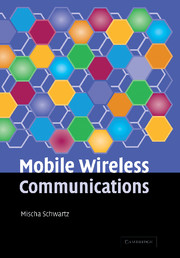Book contents
- Frontmatter
- Contents
- Preface
- 1 Introduction and overview
- 2 Characteristics of the mobile radio environment–propagation phenomena
- 3 Cellular concept and channel allocation
- 4 Dynamic channel allocation and power control
- 5 Modulation techniques
- 6 Multiple access techniques: FDMA, TDMA, CDMA; system capacity comparisons
- 7 Coding for error detection and correction
- 8 Second-generation, digital, wireless systems
- 9 Performance analysis: admission control and handoffs
- 10 2.5G/3G Mobile wireless systems: packet-switched data
- 11 Access and scheduling techniques in cellular systems
- 12 Wireless LANs and personal-area networks
- References
- Index
11 - Access and scheduling techniques in cellular systems
Published online by Cambridge University Press: 05 June 2012
- Frontmatter
- Contents
- Preface
- 1 Introduction and overview
- 2 Characteristics of the mobile radio environment–propagation phenomena
- 3 Cellular concept and channel allocation
- 4 Dynamic channel allocation and power control
- 5 Modulation techniques
- 6 Multiple access techniques: FDMA, TDMA, CDMA; system capacity comparisons
- 7 Coding for error detection and correction
- 8 Second-generation, digital, wireless systems
- 9 Performance analysis: admission control and handoffs
- 10 2.5G/3G Mobile wireless systems: packet-switched data
- 11 Access and scheduling techniques in cellular systems
- 12 Wireless LANs and personal-area networks
- References
- Index
Summary
We have noted throughout this book, in discussing cellular systems, that the radio channel used for communication between mobile stations and a base station limits the communication possible. In particular, whether using TDMA or CDMA as the underlying multiple access technique, only a limited number of users may be accommodated in a given frequency band. Users must thus be given permission to transmit, using a given frequency and a specified number of time slots or codes, as the case may be. To obtain permission to transmit, a user must first access the base station indicating a desire to use the system. The availability, in turn, of only a limited number of access channels, whether a specified set of frequencies and time slots, or frequencies and codes, may result in interfering access attempts or “collisions” by users attempting access at the same time. Most commonly, as seen in our discussion of second- and third-generation cellular systems in Chapters 8 and 10, respectively, random access strategies based primarily on the slotted-Aloha technique are used to provide the necessary access, including mechanisms for resolving “collisions.” In the case of a circuit-switched voice call, once the desired access is made, the user receiving a dedicated time slot or code at a given frequency, as the case may be, this system resource is normally held for the length of the call. The case of packet-switched data in the third-generation systems described in Chapter 10 presents more complex issues.
- Type
- Chapter
- Information
- Mobile Wireless Communications , pp. 361 - 394Publisher: Cambridge University PressPrint publication year: 2004



